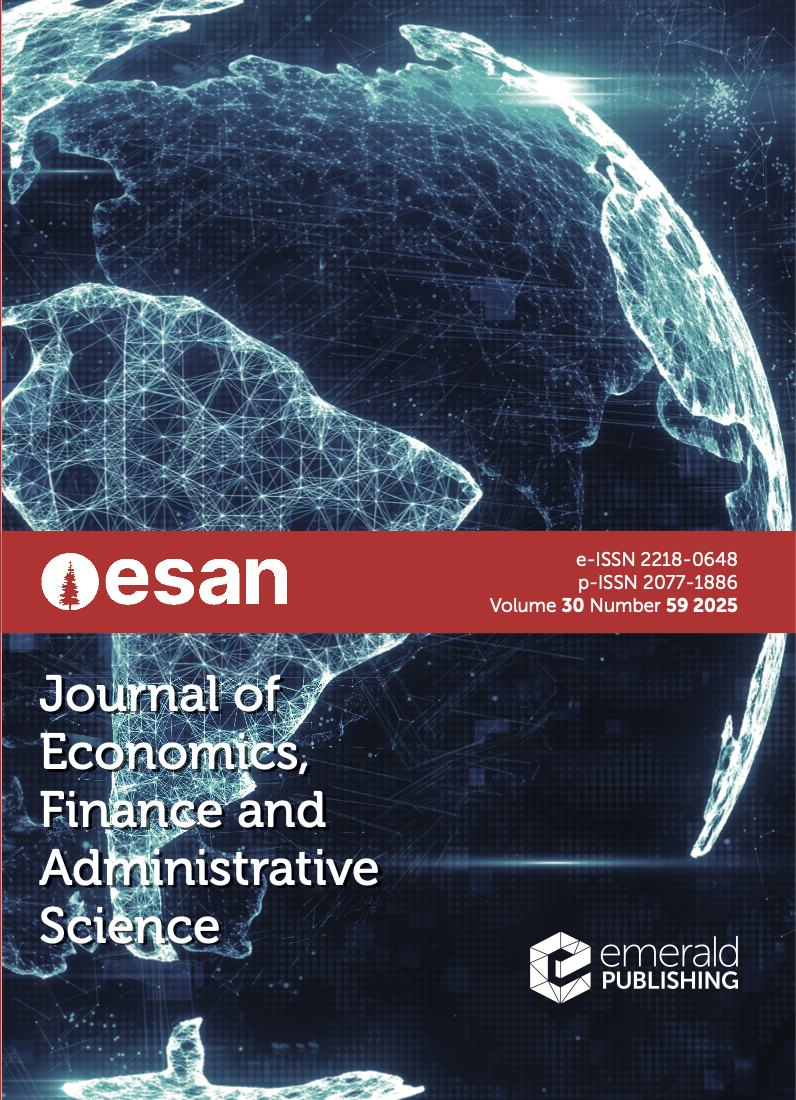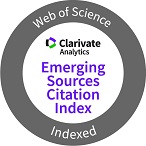Are private banks more sensitive to changes in reserve requirements? Evidence from an emerging market
Keywords:
Monetary policy, Interest rate, Bank profitability, Financial crisisAbstract
PurposeThis article explores the effects of monetary policy rates and interest rate structures on bank profitability.
Design/methodology/approachWe studied 65 Indian commercial banks over time, including economic cycles, consolidation and the Great Financial Crisis. We categorized commercial banks by ownership (public, private or foreign) and predicted how they will react to monetary policy changes. We employed the instrumental variable estimate approach and panel Granger causality tests to give evidence of the direction of causation in the monetary policy and bank performance nexus.
FindingsPrivate and international banks, we believe, are more sensitive to changes in reserve requirements because they are more effective at maintaining statutory reserves. Private and international banks are more susceptible to repo rate fluctuations than state banks. In contrast, public banks are more sensitive to bank rates because they are more likely than private and international banks to use the bank rate window of accommodation.
Originality/valueWe studied the impact of monetary policy rates on bank performance within the banking-dominated financial system of an emerging economy – a focus that has not been previously explored. There has been little research into the connection between monetary policy rates and bank performance in emerging markets, notably in India.
Downloads
References
Albertazzi, U. and Gambacorta, L. (2009), “Bank profitability and the business cycle”, Journal of Financial Stability, Vol. 5 No. 4, pp. 393-409.
Al-Harbi, A. (2019), “The determinants of conventional banks' profitability in developing and underdeveloped OIC countries”, Journal of Economics, Finance and Administrative Science, Vol. 24 No. 47, pp. 4-28, doi: 10.1108/jefas-05-2018-0043.
Alper, K., Binici, M., Demiralp, S., Kara, H. and Özlü, P. (2018), “Reserve requirements, liquidity risk, and bank lending behavior”, Journal of Money, Credit and Banking, Vol. 50 No. 4, pp. 817-827.
Barroso, J., Gonzalez, B. and Van Doornik, B.F.N. (2017), “Credit supply responses to reserve requirement: loan-level evidence from macroprudential policy”, Working Papers Series, Central Bank of Brazil, Research Department, No. 467.
Bats, J.V., Giuliodori, M. and Houben, A.C.F.J. (2023), “Monetary policy effects in times of negative interest rates: what do bank stock prices tell us?”, Journal of Financial Intermediation, Vol. 53, 101003, doi: 10.1016/j.jfi.2022.101003.
Bauer, M. and Rudebusch, G. (2013), “Monetary policy expectations at the zero lower bound”, Federal Reserve Bank of San Francisco Working Paper, 18.
Begenau, J., Piazzesi, M. and Schneider, M. (2015), “Banks' risk exposures”, NBER Working Paper Series No. 21334, July.
Bernanke, B. and Blinder, A. (1992), “The federal funds rate and the channels of monetary transmission”, The American Economic Review, Vol. 82, pp. 901-921.
Bernanke, B. and Gertler, M. (1995), “Inside the black box: the credit channel of monetary policy transmission”, The Journal of Economic Perspectives, Vol. 9 No. 4, pp. 27-48, doi: 10.1257/jep.9.4.27.
Bernanke, B.S., Gertler, M. and Gilchrist, S. (1996), “The financial accelerator and the flight to quality”, The Review of Economics and Statistics, Vol. 78, pp. 1-15, doi: 10.2307/2109844.
Bolt, W., de Haan, L., Hoeberichts, M., van Oordt, M.R.C. and Swank, J. (2012), “Bank profitability during recessions”, Journal of Banking and Finance, Vol. 36 No. 9, pp. 2552-2264, doi: 10.1016/j.jbankfin.2012.05.011.
Borio, C., Gambacorta, L. and Hofmann, B. (2015), “The influence of monetary policy on bank profitability”, BIS Working Papers No. 514, Monetary and Economic Department, Bank for International Settlements.
Breitung, J. (2000), “The local power of some unit root tests for panel data”, in Baltagi, B.H. (Ed.), Nonstationary Panels, Panel Cointegration, and Dynamic Panels, Advances in Econometrics, Vol. 15, pp. 161-178.
Buch, C.M., Eickmeier, S. and Prieto, E. (2014), “In search for yield? Survey-based evidence on bank risk taking”, Journal of Economic Dynamics and Control, Vol. 43 No. 1, pp. 12-30, doi: 10.1016/j.jedc.2014.01.017.
Calomiris, C. and Hubbard, R.G. (1990), “Firm heterogeneity, internal finance, and credit rationing”, Economic Journal, Vol. 100 No. 399, pp. 90-104, doi: 10.2307/2233596.
Canh, P.N., Schinckus, C., Su, D.S. and Chong, F.H.L. (2021), “Institutional quality and risk in the banking system”, Journal of Economics, Finance and Administrative Science, Vol. 26 No. 51, pp. 22-40.
Cecchetti, S.G. (1995), “Distinguishing theories of the monetary transmission mechanism”, Federal Reserve Bank of St. Louis Review, Vol. 77 No. 3, pp. 83-97, doi: 10.20955/r.77.83-97.
Chortareas, G., Garza-Garcia, J. and Girardone, C. (2011), “Banking sector performance in Latin America: market power versus efficiency”, Review of Development Economics, Vol. 15 No. 2, pp. 307-325, doi: 10.1111/j.1467-9361.2011.00610.x.
Dale, S. (2012), “Limits of monetary policy”, Speech at the 44th annual Money, Macro and Finance Conference at Trinity College, Dublin, September 8, 2012.
Delis, M. and Kouretas, G. (2011), “Interest rates and bank risk-taking”, Journal of Banking and Finance, Vol. 35 No. 4, pp. 840-855, doi: 10.1016/j.jbankfin.2010.09.032.
Demirguc-Kunt, A. and Huizinga, H. (1999), “Determinants of commercial bank interest margins and profitability: some international evidence”, The World Bank Economic Review, Vol. 13 No. 2, pp. 379-408, doi: 10.1093/wber/13.2.379.
Dietsch, M. and Lozano-Vivas, A. (2000), “How the environment determines banking efficiency: a comparison between French and Spanish industries”, Journal of Banking and Finance, Vol. 24 No. 6, pp. 985-1004, doi: 10.1016/s0378-4266(99)00115-6.
Dwyer, G.P., Gilevska, B., Nieto, M.J. and Samartín, M. (2023), “The effects of the ECB's unconventional monetary policies from 2011 to 2018 on banking assets”, Journal of International Financial Markets, Institutions and Money, Vol. 87, 101800, doi: 10.1016/j.intfin.2023.101800.
Fang, X., Jutrsa, D., Martinez Peria, S., Presbitero, A.F. and Ratnovski, L. (2022), “Bank capital requirements and lending in emerging markets: the role of bank characteristics and economic conditions”, Journal of Banking & Finance, Vol. 135, p. 105806.
Friedman, M. and Schwartz, A.J. (1963), A Monetary History of the United States, 1867-1960, Princeton University Press, Princeton.
Friedman, B.M., Kuttner, K.N., Bernanke, B.S. and Gertler, M. (1993), “Economic activity and the short-term credit markets: an analysis of prices and quantities”, Brookings Papers on Economic Activity, Vol. 1993 No. 2, pp. 193-266, doi: 10.2307/2534567.
Flannery, M.J. (1981), “Market interest rates and commercial bank profitability: an empirical investigation”, Journal of Finance, Vol. 36, pp. 1085-1101.
Gagnon, J., Raskin, M., Remache, J. and Sack, B. (2011), “The financial market effects of the federal reserve's large-scale asset purchases”, International Journal of Central Banking, Vol. 7, pp. 3-43.
Gertler, M. and Gilchrist, S. (1993), “The role of credit market imperfections in the monetary transmission mechanism: arguments and evidence”, The Scandinavian Journal of Economics, Vol. 95 No. 1, pp. 43-64, doi: 10.2307/3440134.
Hadri, K. (2000), “Testing for stationarity in heterogeneous panel data”, Economic Journal, Vol. 3 No. 2, pp. 148-161, doi: 10.1111/1368-423x.00043.
Hancock, D. (1985), “Bank profitability, interest rates, and monetary policy”, Journal of Money, Credit, and Banking, Vol. 17 No. 2, pp. 189-202, doi: 10.2307/1992333.
Hanweck, G. and Ryu, L. (2005), “The sensitivity of bank net interest margins and profitability to credit, interest rate, and term-structure shocks across bank product specializations”, Working Papers, School of Management, George Mason University.
Islam, N. (1995), “Growth empirics: a panel data approach”, Quarterly Journal of Economics, Vol. 110 No. 4, pp. 1127-1170, doi: 10.2307/2946651.
Joyce, M., Miles, D., Scott, A. and Vayanos, D. (2012), “Quantitative easing and unconventional monetary policy–an introduction”, Economic Journal, Vol. 122 No. 564, pp. 271-288, doi: 10.1111/j.1468-0297.2012.02551.x.
Jung, A. (2023), “Are monetary policy shocks causal to bank health? Evidence from the euro area”, Journal of Macroeconomics, Vol. 75, 103494, doi: 10.1016/j.jmacro.2022.103494.
Kalyvas, A. and Mamatzakis, E. (2014), “Does business regulation matter for banks in the European Union?”, Journal of International Financial Markets, Institutions and Money, Vol. 32, pp. 278-324, doi: 10.1016/j.intfin.2014.06.007.
Kashyap, A.K. and Stein, J.C. (1994), “Monetary policy and bank lending”, in Mankiw, G.N. (Ed.), Monetary Policy, The University of Chicago Press, pp. 221-261.
King, R.G. and Plosser, C.I. (1984), “Money, credit, and prices in a real business cycle”, The American Economic Review, Vol. 74 No. 3, pp. 363-380.
Krishnamurthy, A. and Vissing-Jorgensen, A. (2011), “The effects of quantitative easing on interest rates: channels and implications for policy”, National Bureau of Economic Research, No. w17555.
Levin, A., Lin, C.F., Chu, J. and Chia-Shang (2002), “Unit root tests in panel data: asymptotic and finite-sample properties”, Journal of Econometrics, Vol. 108 No. 1, pp. 1-24, doi: 10.1016/s0304-4076(01)00098-7.
Lozano-Vivas, A. and Pasiouras, F. (2010), “The impact of non-traditional activities on the estimation of bank efficiency: international evidence”, Journal of Banking and Finance, Vol. 34 No. 7, pp. 1436-1449, doi: 10.1016/j.jbankfin.2010.01.006.
Maddala, G. and Wu, S. (1999), “A comparative study of unit root tests with panel data and a new simple test”, Oxford Bulletin of Economics and Statistics, Vol. 61 No. S1, pp. 631-652, doi: 10.1111/1468-0084.61.s1.13.
Majumder, M.T.H. and Li, X. (2018), “Bank risk and performance in an emerging market setting: the case of Bangladesh”, Journal of Economics, Finance and Administrative Science, Vol. 23 No. 46, pp. 199-229, doi: 10.1108/jefas-07-2017-0084.
Memmel, C. (2011), “Banks' exposure to interest rate risk, their earnings from term transformation, and the dynamics of the term structure”, Journal of Banking and Finance, Vol. 35 No. 2, pp. 282-289, doi: 10.1016/j.jbankfin.2010.08.003.
Miller, M. and Modigliani, F. (1958), “The cost of capital, corporation finance, and the theory of investment”, The American Economic Review, Vol. 48 No. 3, pp. 261-297.
Nucera, F., Lucas, A., Schaumburg, J. and Schwaab, B. (2017), “Do negative interest rates make banks less safe?”, Economics Letters, Vol. 159, pp. 112-115, doi: 10.1016/j.econlet.2017.07.014.
Oliner, S.D. and Rudebusch, G.D. (1995), “Is there a bank lending channel for monetary policy?”, Federal Reserve Bank of San Francisco Economic Review, Vol. 2, pp. 3-20.
Pesaran, M.H. (2007), “Simple panel unit root test in the presence of cross-section dependence”, Journal of Applied Econometrics, Vol. 22 No. 2, pp. 265-312, doi: 10.1002/jae.951.
Petersen, W.M. (1986), “The effects of inflation on bank profitability”, in Recent Trends in Commercial Bank Profitability – A Staff Study, Federal Reserve Bank of New York, pp. 89-114.
Plosser, C. (2012), “Economic outlook and the limits of monetary policy”, Speech at the Southern Chester County Chamber of Commerce, October 11.
Praet, P. (2012), “Deleveraging and monetary policy”, Speech at the Hyman P Minsky Conference on Debt, Deficits, and Unstable Markets, November 26.
Rajan, R. (2013), “A step in the dark: unconventional monetary policy after the crisis”, in Andrew Crockett Memorial Lecture, BIS, Basel, June 23.
Rakshit, B. and Bardhan, S. (2023), “Does bank competition affect the transmission mechanism of monetary policy through the bank lending channel? Evidence from India”, Journal of Asian Economics, Vol. 86, 101595, doi: 10.1016/j.asieco.2023.101595.
Samuelson, P. (1945), “The effect of interest rate increases on the banking system”, The American Economic Review, Vol. 35, pp. 16-27.
Sims, C.A. (1992), “Interpreting the macroeconomic time series facts: the effects of monetary policy”, European Economic Review, Vol. 36 No. 5, pp. 975-1000.
Swanson, E. and Williams, J. (2014), “Measuring the effect of the zero lower bound on medium and longer-term interest rates”, National Bureau of Economic Research, No. w20486.
Wright, J. (2012), “What does monetary policy do to long-term interest rates at the zero lower bound?”, Economic Journal, Vol. 122 No. 564, pp. 447-466, doi: 10.1111/j.1468-0297.2012.02556.x.











